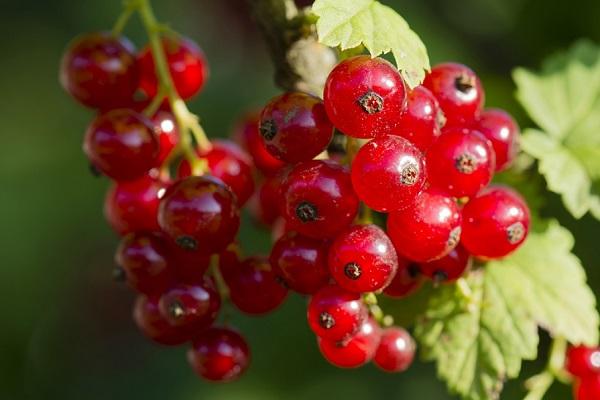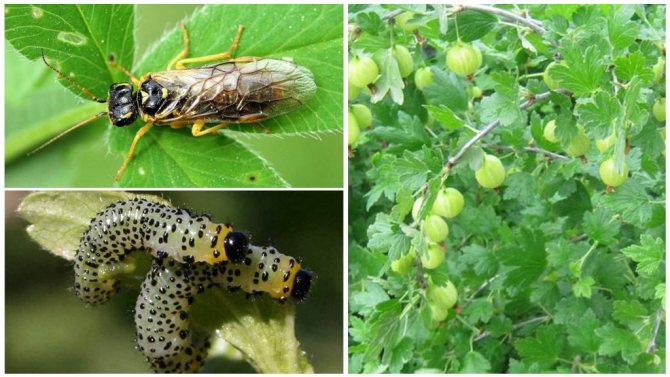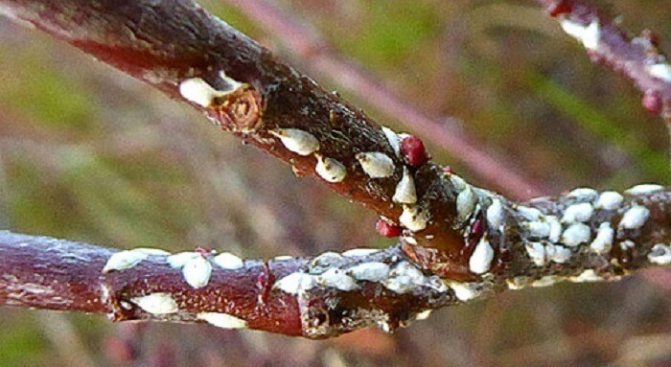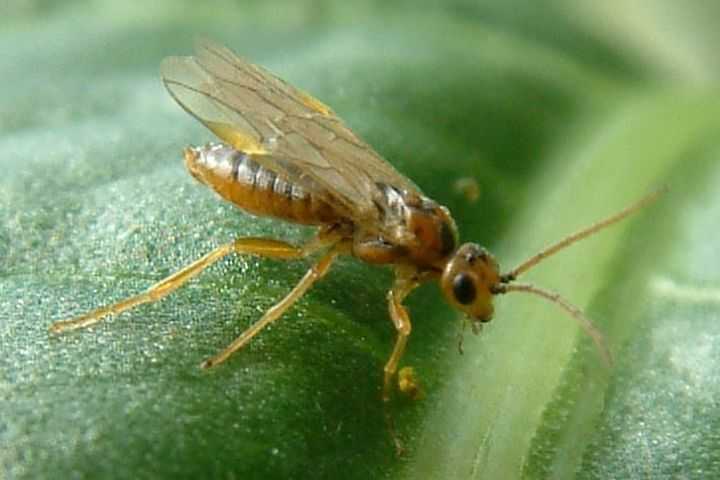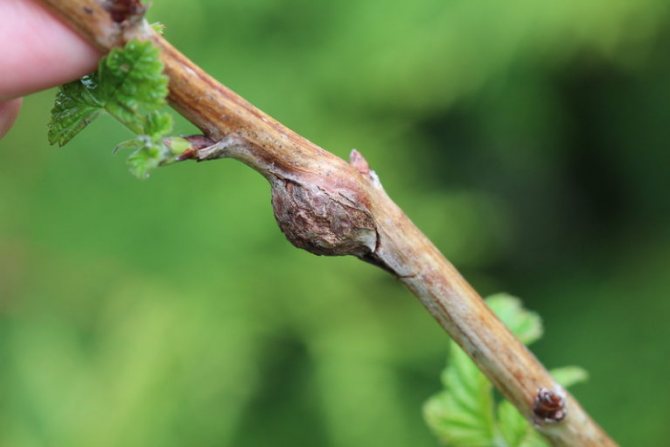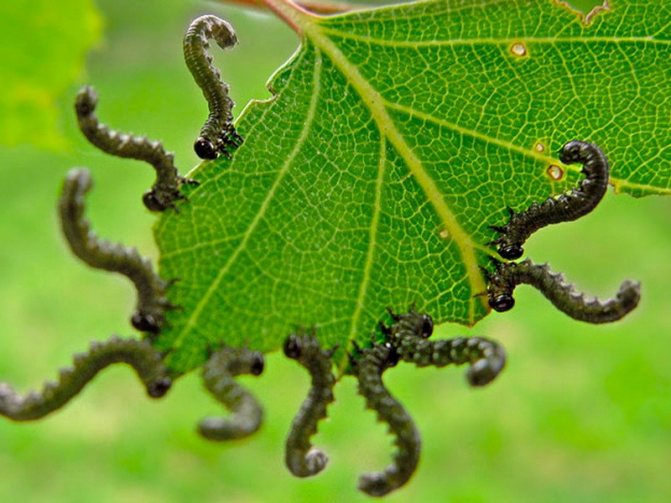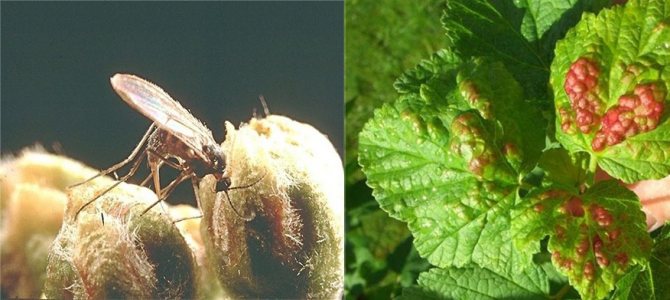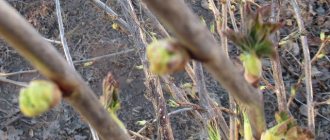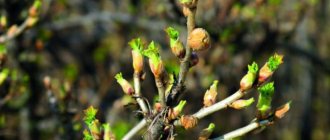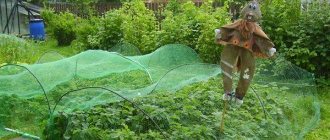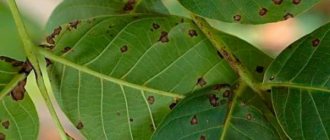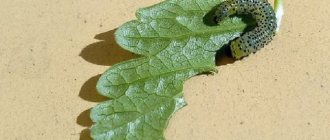Hello dear readers!

If we do not take care of the protection of our currants from all sorts of diseases and pests in time, then all our hopes for a large harvest of this berry may not come true, even if the most productive varieties were planted and you and I perfectly prepared the site for planting them.
And our favorite has plenty of enemies. These are various types of insects and ticks. Total currant pests there are more than 70 species.
Their activity sharply reduces the yield and often leads to the complete death of the crop.
- It is possible to save fragrant shrubs from the attack of gluttonous parasites only with the help of active, immediate and competent protection measures and skillful prevention.
Let's talk about the most common representatives of the evil world, about the effective fight against currant pests and the most effective traditional methods of treatment.
Kidney mite
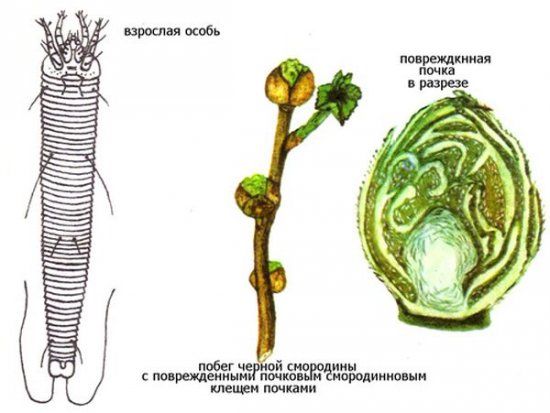

In early spring, at the time of budding, the gardener needs to carefully examine the currant bushes. If you see round, strongly swollen (in the form of a small head of cabbage) pale yellow buds, you should know - your bushes are infected with a dangerous pest -kidney mite... Each bud affected by a mite will not open, but will simply dry out. Each such swollen kidney is home to 3 to 8 thousand ticks and their clutches. During the period of budding and flowering of currants, bud mites come out and move into healthy buds. Females of the kidney mite hibernate in the buds, and in the spring they begin to lay eggs.
Kidney mite control measures:
In early spring, such swollen buds should be plucked out and burned; if severely damaged, cut the bush to the base (if there were no signs of double flowers on it).
Currant pests
Kidney currant mite
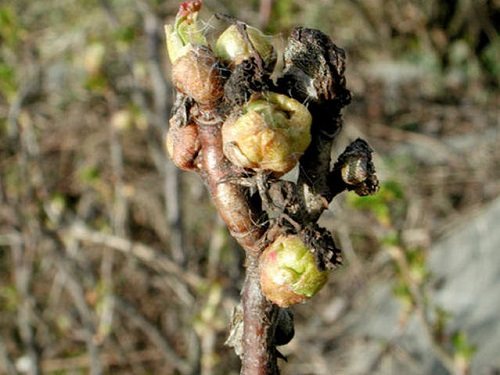

The impudent parasite is one of the most dangerous guests of berry bushes (the pest is especially fond of blackcurrant varieties).
A parasitic creature enters the site along with saplings. Parasites do not like the conditions of humidity and high temperatures.
Therefore, they hide inside the culture (mainly in the ovaries).
- The mite is a tiny representative of the genus of spiders (its size is only 0.2 mm). Ticks are dangerous not only because of their gluttony. They are carriers of many diseases (mycoplasma, terry). The affected culture suddenly loses its immunity, becomes very susceptible to other pests and may die.
When a plant begins to bloom, its buds wither. Females of parasites at this time have to crawl out into the fresh air (this is a single moment in their existence, when currant pests are defenseless).
The parasites are actively looking for a young twig full of juices, in the sinuses of which they can take refuge again and reproduce calmly.
Take a closer look at sleeping currants in winter. Are some of her dormant kidneys enlarged?
Swollen eyes are the most common symptom of the disease. In the spring, a diseased shrub will grow its shoots unevenly, the leaves will become deformed, with a noticeable lag in development.
- A stunted culture will give few flower brushes, and most of the ovaries will never wake up.
In summer, diseased plants become very noticeable, they grossly inhibit development, growth, have an unkempt shrub shape, many shoots are crooked and infantile, there are practically no berries, most of the fruits have withered before they matured.
In the autumn period, the eyes begin to swell, many of them acquire a round shape, they are different in size, which is very striking.
Kidney moth
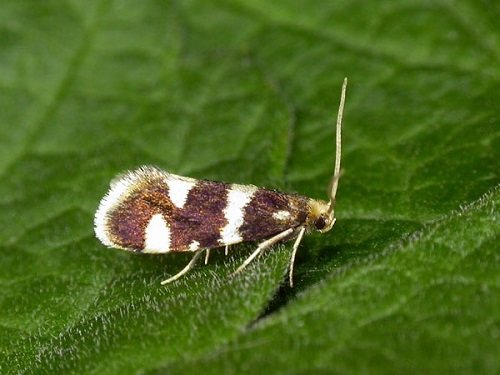

A butterfly with a wingspan of 13-16 mm. It can be distinguished by the color of the wings: the front ones are yellowish-brown, the back ones are brown-gray, fringed.
The caterpillar of this species is warty with a light edging. It changes its color depending on age (red, then brown-yellow, and before pupation it becomes brown-green).
- In the cold season, these currant pests are in dense white cocoons. They can be found under the bark at the base of mature shoots. Her most favorite varieties are red and white currants.
Pests awaken simultaneously with the beginning of the movement of scales on the kidneys. Gluttonous insects gnaw into the core of the eyes.
After the destruction of one ovary, they crawl to neighboring ones. One caterpillar is capable of destroying up to 7 buds.
At the very beginning of May, the parasites turn into pupae, and after 10-12 days, butterflies begin to flutter and actively lay eggs inside the ovary.
The kidney moth is very fertile - one female can lay up to 60 eggs.
Redcurrant aphid


A small insect of black or green color has a size of up to 7 mm.
Small parasites successfully reproduce on young shoots of plants and suck the juices out of them. Aphid eggs wait out the winter on the branches of the bush, with the onset of the warm period larvae appear.
They crawl to the lower part of the leaflet and begin vigorous activity.
- It is easy to spot aphids. In the places of its activity, yellow or brownish-red swellings (galls) appear. Sick leaves curl, darken and crumble. Shoots are deformed, become crooked. A clear sign of the presence of this parasite is the abundance of ants.
Everyone knows that the ant and the aphid are dependent on each other. Ants feed on dew that the pest secretes.
Moreover, goose bumps carry the clumsy aphids on themselves, picking up the most appetizing parts of the plant for it and settling it there.
Spider mite
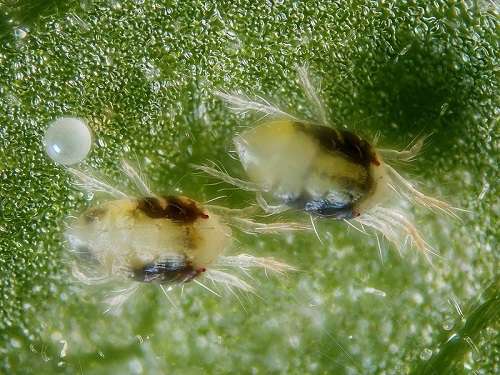

This is another very dangerous pest of black currant, but it does not disdain red varieties either.
Spider mites live on the lower part of the crown of plants. In the course of their life, ticks are engaged in weaving a cobweb, which can be easily found.
- Their presence is also indicated by the appearing light dots on the leaves, which over time completely lose their color. A badly damaged leaf becomes marble, it dries up and falls off.
The plant has a sharp drop in immunity, cold resistance and yield.
The mite hibernates under fallen leaves; it can also live in the upper layer of the soil. As soon as the buds begin to bloom, he climbs onto the bush and begins to spoil the crown.
These mites reproduce mainly on weeds. This is facilitated by a dry, hot season.
Currant gall midges
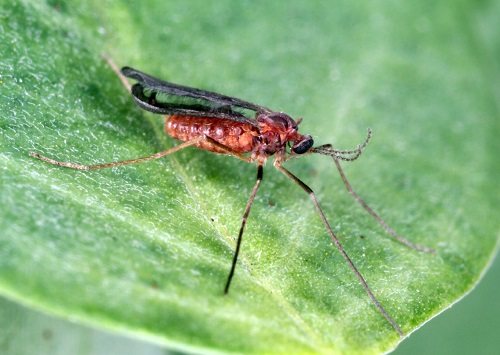

Small flying mosquito insects can infect all parts of plants. In the areas where their larvae feed, currant tissues begin to grow, forming swellings - galls.
- Mostly pests damage blackcurrant varieties. Parasites can be of three types: leaf, flower and stem.
Mature specimens are 2-3 mm long, yellow-brown in color. Their caterpillars are initially white, as they mature, they turn red-orange, at the end of development, scarlet.
All varieties of these pests of currants overwinter in the surface layer of the soil in the larval stage.
When warming, they pupate, and when the shrub begins to bloom, adult insects become more active.
- Floral. Oviposition occurs in flower ovaries. The inflorescences die, taking the shape of a ball or pear. When the larvae are full, they leave the bud into the ground.
- Leafy. Parasites of this species feed on young leaves. They also live there.Damaged leaves stop developing, curl and die. Young shrubs are especially affected.
- Stem. Pests lay eggs after flowering in cracks on the trunk of the currant. The larvae actively nest under the bark, where they gather in large colonies. In the area of their habitat, the bark dies off, and the shoots die. With the global spread of gall midges in the garden, up to 70% of all plantings can be lost.
Currant goldfish


The larvae of this gluttonous beetle willingly eat the core of currant branches. Affected shoots begin to dry, the bush itself sharply loses productivity, the berries that were still able to form become tiny and frail.
- Crawling pests have a flattened shape, slightly widened at the head. They live, hibernate and pupate in the same shoot that they eat away.
Newborn parasites appear at the beginning of the summer season, after 7-10 days, females lay eggs on bush branches.
The eggs of the beetles are poured with mucus, which dries up and forms a hard shield in the form of an oval on the trunk of the bush.
After two weeks, the larvae appear. They immediately penetrate the trunk.
Currant glass
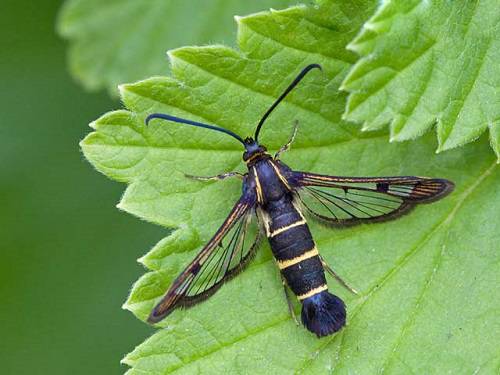

A small winged pest of currants is among the most dangerous parasites for currants of all varieties.
The insect is dangerous because it is very difficult to eradicate - the pest caterpillars live in wood, in the very thick of the bush.
- If you notice in the spring that dried branches stand out sharply among the green foliage, it is quite possible that these are places of pest settlements. Cut the branch with a pruner - in the center of the cut you will see a dark cavity - this is its trace.
Butterflies in an insect of medium size (2-3 cm), they are covered with blackish-lilac scales, below, on the abdomen there are transverse, light stripes.
They appear 10-14 days after the flowering of the shrub (end of June). One individual is capable of laying up to 70 eggs. Laying is done in the cracks of the shoots.
The appeared caterpillars actively eat the core of the trunk and make tunnels there up to 40 cm. They also settle there for the winter.
In autumn, caterpillars grow up to 2 cm, but the plant does not leave. They creep out only in May of the following year for pupation.
Gooseberry moth


A small gray butterfly is the most dangerous pest of currants. Its pupae overwinter in the soil under the plant bushes.
They appear in spring, as soon as the temperature rises to + 10-13 ° C. Soon they begin to lay eggs inside the flowers of the shrub. Sometimes their number reaches 200 pieces.
A week later, caterpillars appear, which give gardeners a lot of trouble.
- The caterpillar actively eats the fruits of the culture, one individual is capable of destroying up to 15 berries. Comparing the number of parasites that can appear simultaneously, it is easy to imagine the scale of their harmful activity.
You can understand that the garden has been attacked by a moth by the presence of rotten berries covered with cobwebs and by the presence of the caterpillars themselves (in adult form, they are bright green in color up to 2 cm long).
Gooseberry shoot aphid


These small sucking insects seriously damage young currant leaves (they especially like blackcurrant varieties).
With their massive invasion, the foliage bends, stops developing and dies. Young crops are extremely affected by the pest.
- The parasite hibernates in the stage of eggs, which in autumn are laid by females on the stems of young plants in the area of the ovaries. In the spring, when they begin to bloom, small larvae appear.
In summer, winged pests of currants scatter throughout the garden and establish huge colonial settlements of harmful insects.
It is quite easy to understand that the garden is infected with aphids: the leaves with their curved edges and curved loop-shaped shoots with enlarged internodes will tell about this.
Gooseberry moth
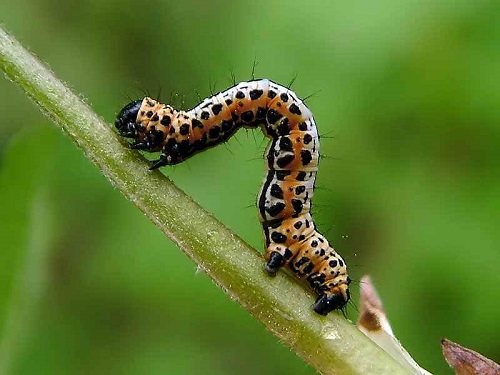

The gluttonous caterpillars of the moth actively and almost completely destroy the leaves of plants (these are pests of red currants, but parasites also do not bypass white varieties).
The moth butterfly is large (up to 5 cm long), with yellow, bright wings. She produces egg-laying from the inner area of the leaves in the second decade of summer.
- Adult caterpillars reach a length of 4 cm, after their active summer activity, by autumn they twine themselves in a spider cocoon, simultaneously with the foliage they fall to the soil, where they hibernate.
Creeping pests are gray in color with yellow stripes on the sides. In the spring they emerge from the cocoon and crawl onto the branches of the bushes, where they begin to actively feast on young leaves.
Currant glass
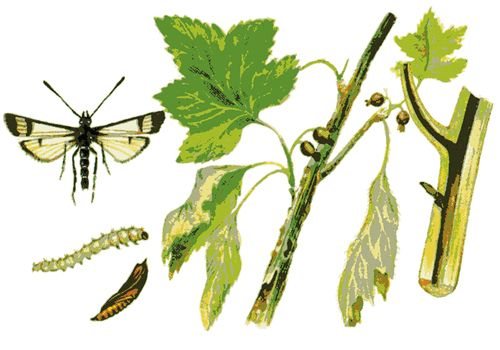

When pruning fertile or broken off branches of currants, there are those in which the core is eaten away and filled with dark brown secretions, and inside a white or pink caterpillar with a brown head sits - this is a currant glass. Butterflies of the currant glass fly out at the end of the flowering of the currant, but the caterpillars eat away the core of the shoots for two years, they hibernate for two winters inside the shoots. Damaged by currant glass, the branches break off and dry out.
Measures to combat currant glass:
Cut damaged shoots to the very base, do not leave stumps, and immediately burn these branches. It is better not to cut young shoots, since it is in the places where the pest butterflies lay their eggs.
Preventive measures
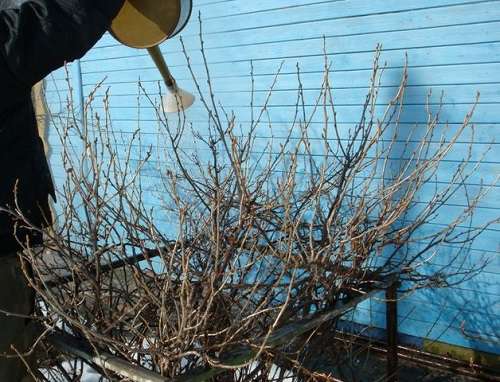

♦ Effective boiling water. Hot water destroys the larvae of various pests of currants that live and winter on the shoots of the bush.
At the same time, the bushes themselves do not suffer from dousing, but only become stronger. When carrying out the procedure, adhere to the following rules:
- Do not use 100% boiling water. Let the water cool slightly.
- Tie the branches of the plant together before the event.
- Pouring over currants is possible only in its dormant state.
Processing of currants from pests is carried out during a period when it has already become warmer, but there is no green haze on the bushes.
You can also pour over the plants in winter, when the shrubbery is freed from the deciduous cover.
♦ Handmade. One of the most effective methods is the manual collection of harmful caterpillars.
In the fall, dig up the soil and spud each bush to a height of 10-12 cm with soil for a radius of up to 70 cm.
Pupae hibernating under plant debris will find themselves at a destructive depth - they will be destroyed by the winter cold.
The layer of earth can be removed 2 weeks after the end of the flowering of the shrub.
♦ Competent care. Do not cut cuttings from plants affected by pests of currants, carefully process and disinfect your working tools (especially after cutting off bushes).
And buy only high-quality seedlings from professional nurseries.
- Perform a thorough sanitary pruning in early spring. To avoid the spread of parasites along with the planting material, harvest the cuttings before the time for the activation of insects after wintering.
Keep track of the status of your plantings! Remove old stumps, dry shoots, do not leave plant residues, leaves under bushes (burn them in a timely manner).
Do a general garden cleaning every fall. Remove all weeds, dig up the soil well, and in the spring, collect all the remnants of grass and dry leaves.
♦ Down with ants. The fight against aphids of all types must begin with the destruction of ant colonies.
Try to find an anthill and pour boiling water over it in the spring.
After the ants are gone, you can also kill the aphids. She hides inside the kidneys. At the same time, the eyes have an enlarged, rounded shape.
All such ovaries must be collected and burned. You also need to regularly remove excess growth.
Be sure to clean the bark if it starts to flake off - there may be eggs in there.
♦ Beneficial insects. Such beneficial insect entomophages as aphelinus, aphidimiza gall midge, trichogramma and others are opposed to the dispersal of many pests of currants.
To attract them, fragrant melliferous herbs (oregano, rosemary, calendula, cosmea, mallow, marigolds) should be planted on the site.
Entomophages are also attracted by other plants (parsley, clover, sunflower, buckwheat, dill, celery).
- Ladybugs, hoverflies, lacewings are good for fighting many types of parasites. They will appear if there are chamomile, tansy, coltsfoot, dandelions, evergreen shrubs, ferns in the garden.
Take your time to rid your garden of weeds. It's about a swan. It must be left near the currant at least 1-2 bushes.
Quinoa is a great treat for some types of noxious insects. The weed is able to take a hit on itself, and as soon as you see that the plant is affected by currant pests, destroy it.
Means of protection and prevention
An important preventive measure is proper care of the near-trunk circles. Since many parasites hibernate under a layer of fallen leaves, all the garbage must be removed and burned, and the earth must be loosened and dug up.
For prevention, you can use infusions of onions, garlic, red pepper and marigolds. It is very important to constantly monitor the condition of currant bushes and timely pruning of diseased and damaged branches. If the plant is severely affected, then it should be completely uprooted and burned.
Folk ways
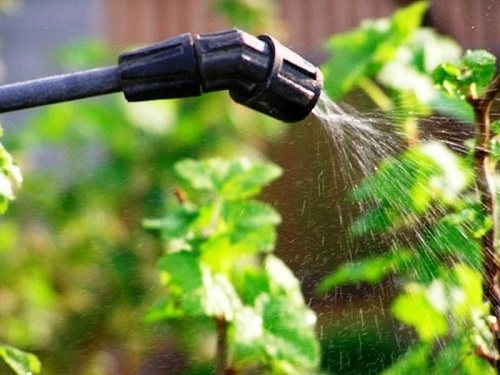

| How to treat currants from pests | What to do | Against whom is it directed |
| Onion | Finely chop the onion (15-20 g), pour in a liter of water. Insist 5-7 hours | Mites |
| Dandelion medicinal | Pour the roots of the plant (20 g) with warm water (1 l). Leave for 1-2 hours | |
| Garlic | Dilute crushed garlic cloves (150-170 g) with a liter of water. Put in a dark place for 5 days. Before use, dilute 5-6 ml of concentrate with water (1 l) | |
| Laundry soap | Add soap shavings (30 g) to water (1-1.5 l) | Aphid |
| Wood ash | Ash (2 kg) is diluted with a bucket of boiling water. Insist 2 days. | |
| Mustard | Pour mustard powder (60 g) with hot water (1-2 l). Let stand for 3 days. The concentrated liquid is diluted with 3 liters of water | |
| Tobacco | Add tobacco (300 g) to a bucket of boiling water. Withstand 2 days and add 30 g of household soap | |
| Needles | Spruce / pine needles (glass) to insist in hot water (2 l) for 5-6 days. Dilute 1x10 | |
| Burdock | Pour the crushed leaves of the plant (½ bucket) with water, stand for 3 days | Moth |
| Sagebrush | Boil dried plants (1 kg) in a small amount of water for 10-15 minutes. Dilute the resulting solution with 10 liters of water | Caterpillars and larvae of parasites |
| Tomatoes | Chop the tops finely. Add it (1 kg) to 10-12 liters of water. Boil for half an hour, then stir in household soap (40 g) | |
| Bitter pepper | Pour finely chopped pods (100 g) with a liter of water, boil for an hour, leave for 2 days. For use, dilute the filtered solution (for 10 liters of water ½ glass of the composition, add 40 g of soap) |
It is necessary to spray plants with such compositions.
It should be processed at a distance of 10-15 cm from the bush, so you more evenly distribute the healing tinctures / decoctions.
Now watch a video on how to protect currants from aphids and currant moths.
And one more video about how now, without waiting for spring, you can fight the kidney currant mite.
See you soon, dear readers and health to your garden!
Currant gall midge


On the currant bushes, you can see that the blossoming upper leaves are wrinkled, as if disfigured, torn, they turn brown and dry out. If such leaves are opened, then yellowish larvae of leafy currant gall midge sit inside, which scrape off the upper skin of the leaf.
Control measures for currant leaf gall midge:
Collect and destroy the leaves with the larvae, but do not leave them in the garden, as the larvae will go to pupate in the soil, and then the second and third generation will appear, living until September.
Blackcurrant berry sawfly
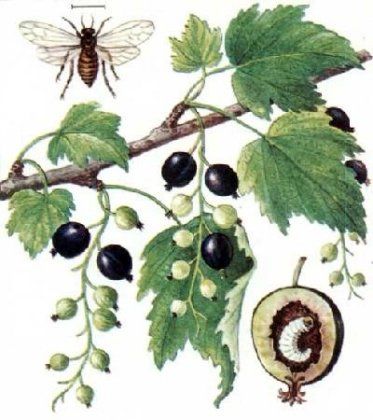

This pest damages black currant berries. Females lay eggs one at a time at the bases of the largest ovaries. Caterpillars of off-white color feed inside the formed ovaries, destroying seeds and some pulp. By the second half of June, such berries grow strongly, acquiring a characteristic ribbed shape and color prematurely, as if ripening. In July, the larvae gnaw round holes in the berries and hibernate in the soil, and the damaged berries fall off.
Control measures for sawflies are the same as for gooseberry moth.
Currant shoot gall midge
The larvae of the currant shoot gall midge penetrate under the bark in the lower part of the lignified shoots. Dark, depressed spots and cracks appear on the damaged areas. In the middle of summer, damaged shoots suddenly break off easily. The adults of the shoot gall midge are orange-red; they hibernate in the soil in September-October.
Control measures against gall midges:
In the fall, you need to cut out (without leaving stumps) and burn the branches damaged by the larvae of the shoot gall midge, and also dig up the soil under the bushes to destroy the larvae wintering there.
Resistant varieties
Until now, unfortunately, breeders have not developed varieties that would have absolute resistance to such a pest as glass. However, there are species with a certain level of endurance.
Black currant
Blackcurrant varieties that are able to withstand the pest:
- Vigorous.
- Summer resident.
- Sechenskaya-2.
- Perun.
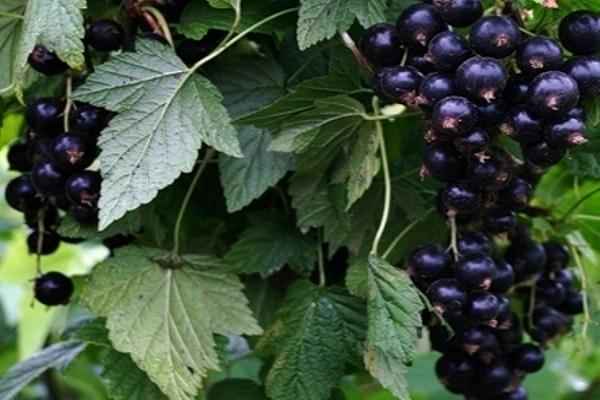

Red currant
Red currant varieties that have the ability to resist the pest:
- Early sweet.
- Natalie.
- Jonker Tets.
